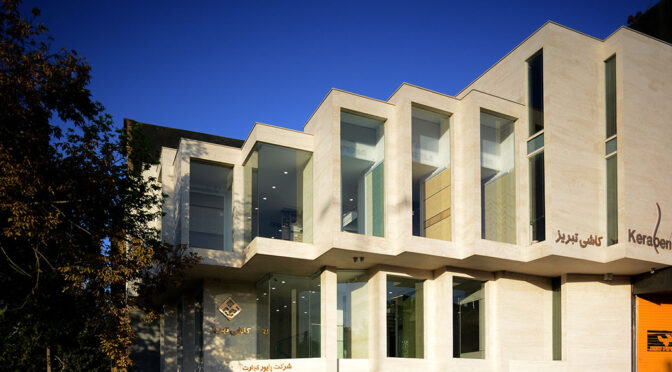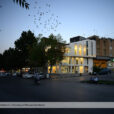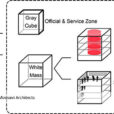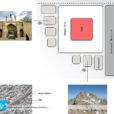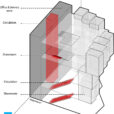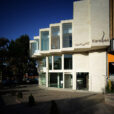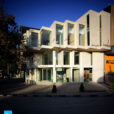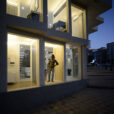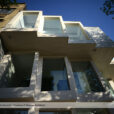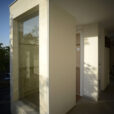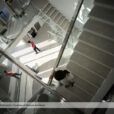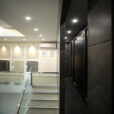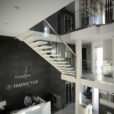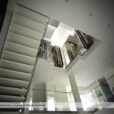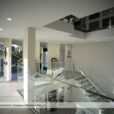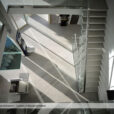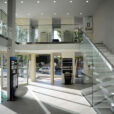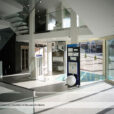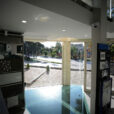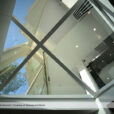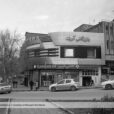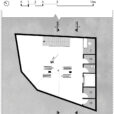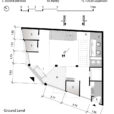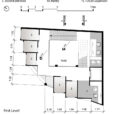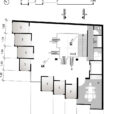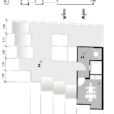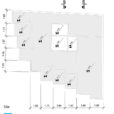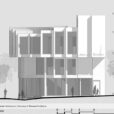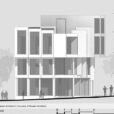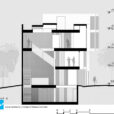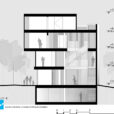بازسازی نمایندگی کاشی تبریز و کرابن
دفتر معماری موسوی و همکاران (سیدجلیل موسوی)
موقعیت: همدان، ایران
تاریخ: ۱۳۹۶
مساحت: ۳۵۲ مترمربع
وضعیت: ساختهشده
کارفرما: شرکت پایور تجارت
تیم طراحی: راضیه شعاعی، سیدآکام کاتورانی، سپهر عدالتی مرفه، الهه افروخته، علیرضا مرادی مشکین، سنبل حاتمی، هومن سعادت
سازه: کیوان صلواتی
تاسیسات الکتریکی: میثم شکریه
عکس: علی دقیق
جوایز: رتبه سوم گروه بازسازی جایزه معمار ۱۳۹۶
فروشگاه در طی ۲۰ سال گذشته، سه بار دچار تغییرات شده بود و آخرین بار به درخواست شرکت تولیدکننده کاشی تبریز و کرابن، نمای ساختمان با استفاده از ورقهای کامپوزیت پوشش داده شده بود، اما هیچ یک از تغییرات در نهایت نتوانسته بودند رضایت مالک و شرکت را جلب کنند. هنگامی که کار به دفتر ما ارجاع شد، آنچه در بررسی بنا جلب نظر میکرد، دو نکته مهم بود:
ـ بستهبودن فضا و ارتباط ضعیف طبقات با یکدیگر، به گونهای که مراجعین هیچ تصوری از طبقه بالا که فضای نمایشگاهی بسته در آن وجود داشت و نیز زیرزمین که محصولات جانبی را در آن قرار داده بودند، نداشتند.
ـ سختی انتخاب کاشی برای مشتریان، به دلیل تنوع زیاد و عدم تصور چیدمان در فضاهای مورد نظر.
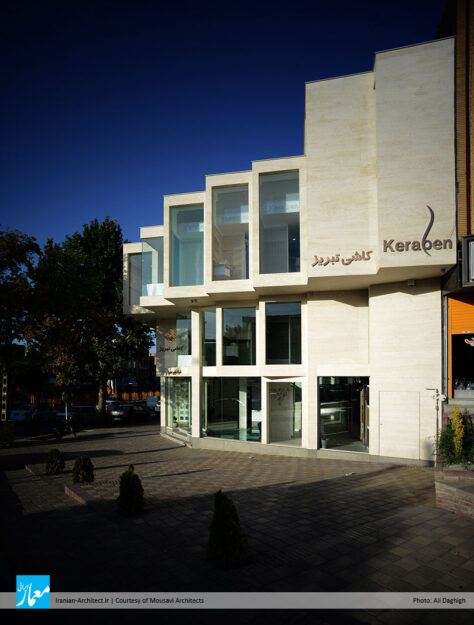
دو مسئله فوق که در بررسی اولیه بنا به آنها رسیدیم، مبنای شکلگیری ایده اصلی بازسازی قرار گرفتند:
ـ شفافیت در فضاها و سیرکولاسیون مشخص در طبقات، بهگونهای که مراجعین در ابتدای ورود بتوانند درک درستی از تمامی ابعاد فضا داشته باشند و همچون یک گالری، سیرکولاسیون واضحی بین طبقات وجود داشته باشد.
ـ قابل لمس و تصور کردن محصولات، چرا که با دقت در نحوه رفتار مشتریان متوجه شدیم که در خرید کاشی دو موضوع اهمیت دارد: ابتدا انتخاب رنگ، ابعاد و بافت کاشی که با مواجهه و لمس آنها صورت می گیرد، و دوم تصور چگونگی چیدمان آنها که چالش اصلی برای خریداران است.
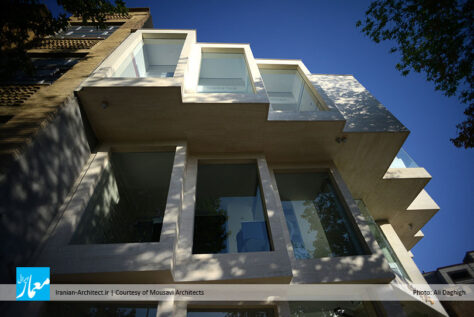
بر اساس آنچه گفته شد، لمس و تصور، و شفافیت فضایی، به عنوان موضوعات اصلی در شکلگیری پروژه بازسازی فروشگاه قرار گرفتند. بدینمنظور مکعبهایی با ابعاد مختلف و متناسب با اندازه سرویس و حمامهای مرسوم در داخل خانهها، در بدنه اصلی ساختمان قرار گرفتند که به عنوان Showroom، مرز درون و برون را شکل دادند. به این ترتیب، به جز مشتریان، عابران هم شاهد انواع چیدمانهای کاشی و سرامیک هستند و با تغییر در چیدمان، تغییر دایمی در نما صورت میگیرد. از سوی دیگر، فضایی برای طراحی و چیدمان دیجیتالی انواع کاشی و سرامیک در نظر گرفته شد، به گونهای که مشتریان میتوانند ابعاد فضاهای مورد نظر خود را به اپراتور بدهند و با نظر خود آنان چیدمان صورت گیرد و نتیجه را در صفحه نمایش بزرگ کنار میز فروش مشاهده کنند. بنابراین با بازدید از فضاهای نمایش واقعی و نیز با استفاده از نرمافزار و نمایش دیجیتالی، حداکثر کمک به مشتریان در راستای انتخاب و خرید صورت میگیرد. در واقع، دیدن، لمس، طراحی و نمایش، انتخاب و خرید را به یک ویژگی لذتبخش در این پروژه تبدیل کرده است.
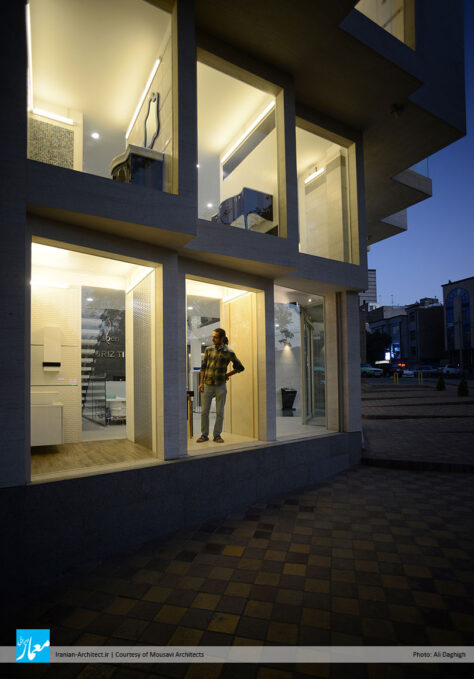
در سازماندهی خطوط اصلی بنا، هماهنگی با نیروهای سایت مد نظر قرار گرفت، به گونهای که دید به مکان مذهبی روبروی فروشگاه (امامزاده یحیی) و از طرف دیگر، جهتگیری به سمت کوه الوند، به عنوان شاخصه مهم جهتیابی طبیعی در شهر، و نیز هماهنگی با پنجرههای اصلی و مشاهده آنها از سوی عابران، به مبنای اصلی چگونگی جهتگیری خطوط اصلی بنا بدل شد.
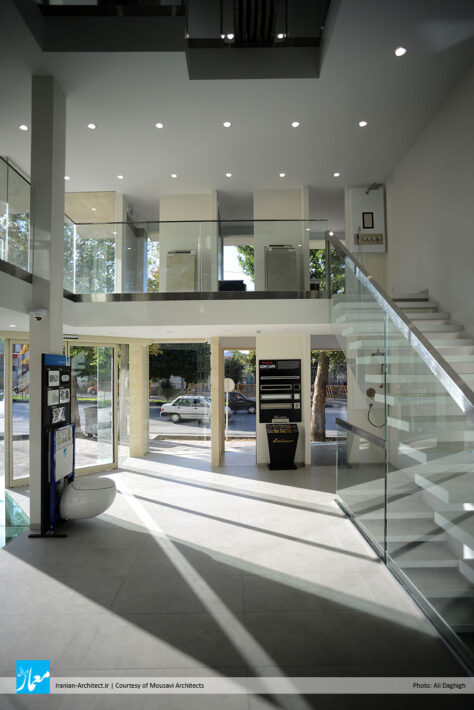
نکته دیگر در بازسازی، تبدیل [اصطلاحا] بالکن فروشگاه که معمولا به عنوان فضای دستدوم و انباری مورد استفاده قرار میگیرد، به طبقهای برای دسترسی به Showroomهای سطح دوم و مسیر ارتباطی طبقه همکف و دوم بود. در نتیجه، این فضا توانست نه به عنوان بالکن درون فروشگاه، بلکه به عنوان طبقه اول قلمداد شود.
Tabriz Tile & Keraben Ceramic Showroom Renovation
Mousavi Architects (Seyed Jalil Mousavi)
Location: Hamedan, Iran
Date: 2017
Area: 352 sqm
Status: Completed
Client: Payvar Tejarat Co.
Design Team: Razieh Shoaee, Seyed Akam Katoorani, Sepehr Edalati Morafah, Elaheh Afrookhteh, Alireza Moradimeshkin, Sonbol Hatami, Hooman Saadat
Structure: Keyvan Salavati
Electrical Consultant: Meysam Shokrieh
Photo: Ali Daghigh
Awards: 3rd Place of Memar Award 1396 in Renovation Category
The store had undergone changes three times, during the past twenty years. When we were contacted about the job, two problems caught our attention:
|- The closedness of the space and the poor connection between the floors; The visitors were unable to form a mental image of the upper floor where products were on display in a closed space and the basement in which accessories and other items were stored.
|- The customers’ struggle to choose, because of the wide variation of the products and having a hard time visualizing the desired arrangement in the target space.
The solution to these two problems formed the basis of the renovation project:
|- Clarity in spaces and a fluent circulation between the floors, in a manner that the customers could form the right idea about the dimensions of the space as soon as they entered the building and that movement could easily flow between the floors like a gallery. |- A study of the visitors’ behaviors revealed that two aspects are important for the customers in buying tiles: first, the color, the dimensions and the texture, which are decided by seeing and touching, and second, visualization of a picture of the selected tiles as installed in the target space, which was the main challenge for the customers.
Therefore, touch, visualization and space clarity became the pivots of the project. To this end, a number of cubic spaces with varying sizes representing common bathrooms were constructed into the main body of the building to be used as “showrooms”, and these spaces formed the boundary between the interior and the exterior. In addition to the customers, pedestrians are now able to window-shop different tile arrangements and a change in the arrangements will cause a permanent change in the façade. Also, a space was implemented for digital design and arrangement of tiles. Now, customers can set the desired dimensions and an operator will digitally arrange the selected tiles based on customer preferences in a big screen adjacent to the counter. The flow of seeing, touching, designing and displaying has turned tile shopping into an enjoyable experience in this project.
Concordance with the site forces became the main criterion for organizing the main lines of the building. Therefore, having visual access to the shrine across the store (Imamzadeh Yahya) on the one hand, and Mount Alvand as a natural landmark for urban navigation on the other as well as harmony with the main widows and being seen by pedestrians, were used as guidelines for determining the direction of the building lines.
Another step in the renovation process was converting the so-called “balcony” of the store which was being used as a secondary space for storing items, into a passage for accessing the second-level showrooms, and an area which would connect the ground floor to the second floor. Thus, this space would no longer be a mere balcony; rather, it would act as the first floor of the building.

